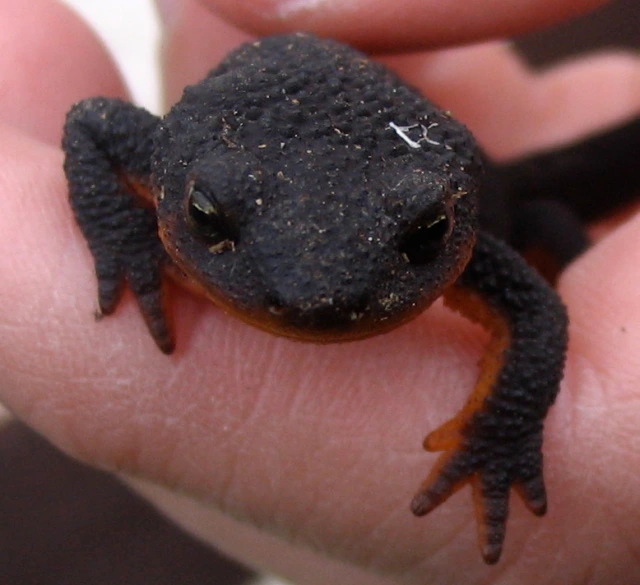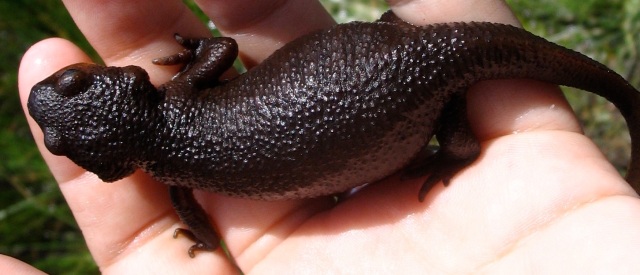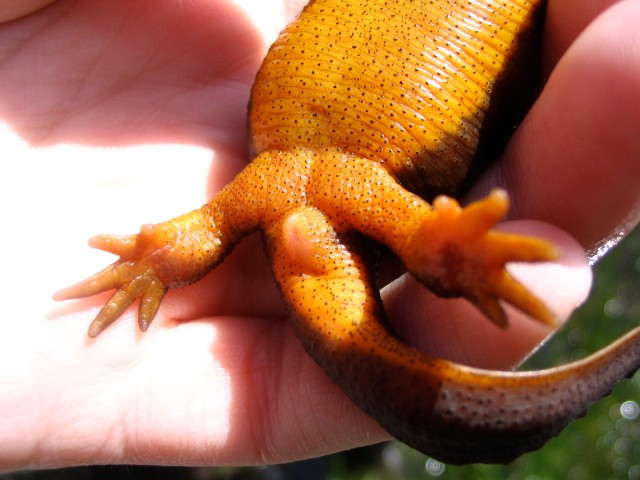
A rough-skinned newt pauses from his squirmy escape attempts. Image taken at Angelo Reserve, California.
The year was 1979, on a night filled with fun and games and of course tons and tons of alcohol. The excitement of the evening died down when all in company started noticing that something was wrong with one of their companions. He was a man, 29 years old, drunk off whiskey who was becoming numb and weak. He told them he thought he was going to die. Still, he refused to go to the hospital. He was left alone. In 15 minutes, his heart gave out.
Flashback, to right before the problems began. In their drunken madness, someone thought it would be funny if our victim ate a rough-skinned newt. He dared him to do it. Who can resist the temptation of a dare? He swallowed a newt and it was his fatal mistake.
He’s not the only one to succumb to this temptation. A 36 year old man, also inebriated, consumed 5 rough-skinned newts on a dare. He could just barely walk. He was dizzy and was vomiting. He had trouble coordinating his muscles. He went to the hospital and was treated and he survived. He was very fortunate.
It’s hard to believe that this inoffensive adorable little newt could cause these problems, but in fact, in terms of sheer potency, you are arguably looking at the deadliest animal in our country-worse than rattlesnakes or black widow spiders. This little newt is the only land animal to contain tetrodotoxin, an incredibly potent neurotoxin, that is also found in the deadly puffer fishes (I recall a Simpson’s episode where Homer eats improperly cut puffer fish sushi and believes he only has 24 hours to live) and the blue-ringed octopus. The octopus gets its toxin from another organism living inside of it, however there is some evidence that this newt can produce its own toxin.

Full body view of a rough-skinned newt. Despite its neurotoxin, I can hold it in my hand as long as I avoid touching my face and wash my hands afterward. The toxin is only a problem when consumed. Image taken at Milagra Ridge in the San Francisco Bay Area.
Fortunately, this neurotoxin is only a problem if the newt is consumed. It doesn’t leach into its environment, which also means it doesn’t have any effect on our drinking water (yay!). For the most part, as long as we can avoid eating these animals, they’ll have few negative effects on us. (Apparently, this is easier said than done. I really just mentioned a couple of cases of grown men eating these guys, but there has also been instances of small children trying to stick these amphibians in their mouths and getting sick. For the record, my new state, Oregon, has the record for death by newt.)
The same can be said for other animals that might prey on the newt. If predators just choose a different meal, then they won’t be poisoned. So, how do they know to avoid this newt? Well, the newt gives them a warning. It’s called the unken reflex, where they arch their back in such a way that their head and their tail move toward each other. This exposes their bright belly.

The bright belly of a rough-skinned newt. Also, notice the vent on this animal is cone shaped, which indicates to us that this is a female. Image taken at Milagra Ridge in the San Francisco Bay Area.

The bright warning color of this newt covers its entire underside. Image taken at Milagra Ridge in the San Francisco Bay Area.
What’s interesting is that research has shown that its the position as well as the coloration that deters predators. The color alone is not as effective. The behavior is also important. I couldn’t tell you with certainty why.
So, predators are given a warning and they now know not to eat this newt. But every animal has to have a nemesis. In the case of the rough-skinned newt, that is the common garter snake. The newt and the garter snake seem to be co-evolving. The garter snakes have developed a resistance to the newt toxin. In fact, after consuming a newt, the snakes become poisonous, storing the toxin in their liver for up to seven weeks. Three weeks after eating just one newt, the garter snake still has enough toxin in its liver to kill a bird predator.
The strength of a rough-skinned newt’s toxin varies in intensity geographically. Some populations have a stronger toxin than others. It seems that in some areas, the garter snakes tend to leave the newts alone, so it doesn’t benefit the newt to have a more potent toxin and the loss of energy from making a more potent toxin could be detrimental to its survival or reproduction. In other areas, the snakes prey heavily on newts, causing selection for higher toxicity. But there is still a limit to how toxic a newt can get and still benefit. If a newt has the right level of toxin, garter snakes are known to throw them up. Sometimes up to 85 minutes after a newt has been eaten, it will be vomited up ALIVE! However, if their poison is too strong, the snake can be paralyzed before the newt is regurgitated, selecting against an even more potent newt.
Aside from the research done involving this newt’s toxin and co-evolution with garter snakes, other interesting studies have been conducted as well. While these newts have pretty stable populations right now and are surviving pretty well (considering the overall amphibian decline), there was some interesting finds involving them and exposure to UV radiation. It was hypothesized that UV, combined with many other factors (including the chytrid fungus), was partly behind the world wide amphibian decline. Research indicated that for these newts, exposure to UV radiation altered their anti-predator behavior and also enhanced the toxicity of PAHs, contaminant found in ponds and streams that often comes from runoff or industrial discharge. This study was conducted involving other amphibian species as well, and it turns out that some amphibians have more resistance to damage or problems from UV radiation than others.
Anyway, if you want to catch a glance of these amphibians, now’s a good time. As is gets colder and wetter, these animals start to look for places to overwinter on land, so you can see lots of them out and about. Just be sure to drive carefully, as many get squashed on roads at this time of year as well.
Last but not least, here is one last picture of my little friend, right before she got her wish and was released back into her pond.


